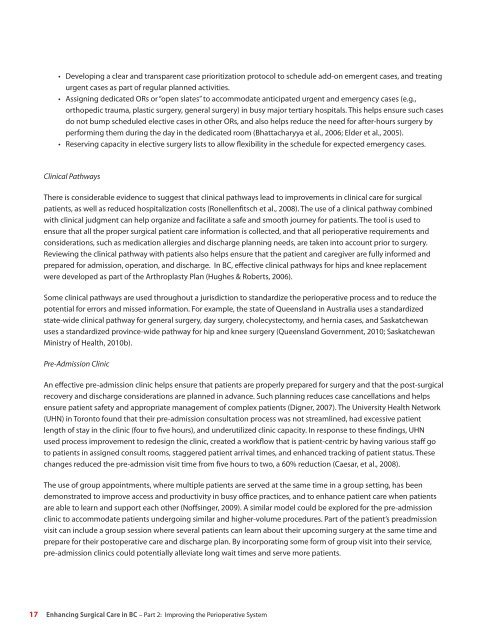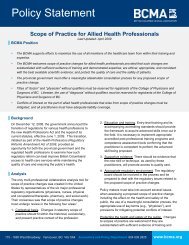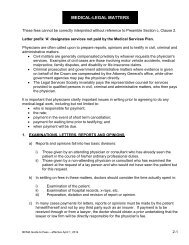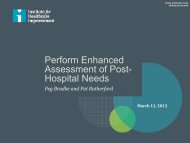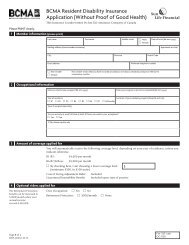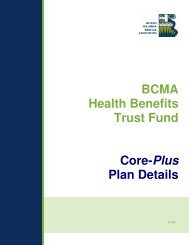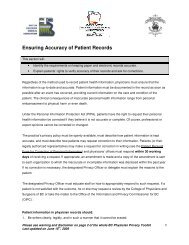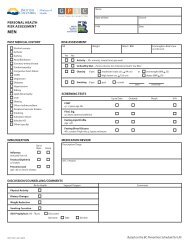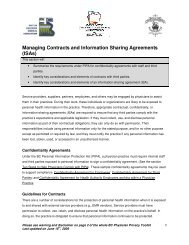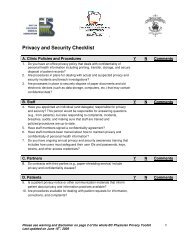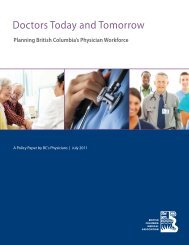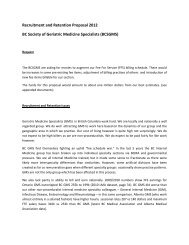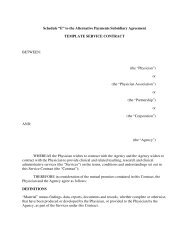Enhancing Surgical Care in BC - British Columbia Medical Association
Enhancing Surgical Care in BC - British Columbia Medical Association
Enhancing Surgical Care in BC - British Columbia Medical Association
You also want an ePaper? Increase the reach of your titles
YUMPU automatically turns print PDFs into web optimized ePapers that Google loves.
• Develop<strong>in</strong>g a clear and transparent case prioritization protocol to schedule add-on emergent cases, and treat<strong>in</strong>g<br />
urgent cases as part of regular planned activities.<br />
• Assign<strong>in</strong>g dedicated ORs or “open slates” to accommodate anticipated urgent and emergency cases (e.g.,<br />
orthopedic trauma, plastic surgery, general surgery) <strong>in</strong> busy major tertiary hospitals. This helps ensure such cases<br />
do not bump scheduled elective cases <strong>in</strong> other ORs, and also helps reduce the need for after-hours surgery by<br />
perform<strong>in</strong>g them dur<strong>in</strong>g the day <strong>in</strong> the dedicated room (Bhattacharyya et al., 2006; Elder et al., 2005).<br />
• Reserv<strong>in</strong>g capacity <strong>in</strong> elective surgery lists to allow flexibility <strong>in</strong> the schedule for expected emergency cases.<br />
Cl<strong>in</strong>ical Pathways<br />
There is considerable evidence to suggest that cl<strong>in</strong>ical pathways lead to improvements <strong>in</strong> cl<strong>in</strong>ical care for surgical<br />
patients, as well as reduced hospitalization costs (Ronellenfitsch et al., 2008). The use of a cl<strong>in</strong>ical pathway comb<strong>in</strong>ed<br />
with cl<strong>in</strong>ical judgment can help organize and facilitate a safe and smooth journey for patients. The tool is used to<br />
ensure that all the proper surgical patient care <strong>in</strong>formation is collected, and that all perioperative requirements and<br />
considerations, such as medication allergies and discharge plann<strong>in</strong>g needs, are taken <strong>in</strong>to account prior to surgery.<br />
Review<strong>in</strong>g the cl<strong>in</strong>ical pathway with patients also helps ensure that the patient and caregiver are fully <strong>in</strong>formed and<br />
prepared for admission, operation, and discharge. In <strong>BC</strong>, effective cl<strong>in</strong>ical pathways for hips and knee replacement<br />
were developed as part of the Arthroplasty Plan (Hughes & Roberts, 2006).<br />
Some cl<strong>in</strong>ical pathways are used throughout a jurisdiction to standardize the perioperative process and to reduce the<br />
potential for errors and missed <strong>in</strong>formation. For example, the state of Queensland <strong>in</strong> Australia uses a standardized<br />
state-wide cl<strong>in</strong>ical pathway for general surgery, day surgery, cholecystectomy, and hernia cases, and Saskatchewan<br />
uses a standardized prov<strong>in</strong>ce-wide pathway for hip and knee surgery (Queensland Government, 2010; Saskatchewan<br />
M<strong>in</strong>istry of Health, 2010b).<br />
Pre-Admission Cl<strong>in</strong>ic<br />
An effective pre-admission cl<strong>in</strong>ic helps ensure that patients are properly prepared for surgery and that the post-surgical<br />
recovery and discharge considerations are planned <strong>in</strong> advance. Such plann<strong>in</strong>g reduces case cancellations and helps<br />
ensure patient safety and appropriate management of complex patients (Digner, 2007). The University Health Network<br />
(UHN) <strong>in</strong> Toronto found that their pre-admission consultation process was not streaml<strong>in</strong>ed, had excessive patient<br />
length of stay <strong>in</strong> the cl<strong>in</strong>ic (four to five hours), and underutilized cl<strong>in</strong>ic capacity. In response to these f<strong>in</strong>d<strong>in</strong>gs, UHN<br />
used process improvement to redesign the cl<strong>in</strong>ic, created a workflow that is patient-centric by hav<strong>in</strong>g various staff go<br />
to patients <strong>in</strong> assigned consult rooms, staggered patient arrival times, and enhanced track<strong>in</strong>g of patient status. These<br />
changes reduced the pre-admission visit time from five hours to two, a 60% reduction (Caesar, et al., 2008).<br />
The use of group appo<strong>in</strong>tments, where multiple patients are served at the same time <strong>in</strong> a group sett<strong>in</strong>g, has been<br />
demonstrated to improve access and productivity <strong>in</strong> busy office practices, and to enhance patient care when patients<br />
are able to learn and support each other (Noffs<strong>in</strong>ger, 2009). A similar model could be explored for the pre-admission<br />
cl<strong>in</strong>ic to accommodate patients undergo<strong>in</strong>g similar and higher-volume procedures. Part of the patient’s preadmission<br />
visit can <strong>in</strong>clude a group session where several patients can learn about their upcom<strong>in</strong>g surgery at the same time and<br />
prepare for their postoperative care and discharge plan. By <strong>in</strong>corporat<strong>in</strong>g some form of group visit <strong>in</strong>to their service,<br />
pre-admission cl<strong>in</strong>ics could potentially alleviate long wait times and serve more patients.<br />
17 <strong>Enhanc<strong>in</strong>g</strong> <strong>Surgical</strong> <strong>Care</strong> <strong>in</strong> <strong>BC</strong> – Part 2: Improv<strong>in</strong>g the Perioperative System


